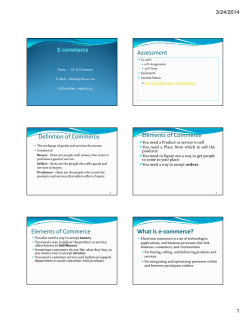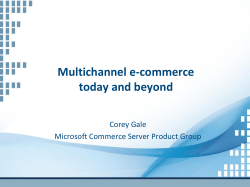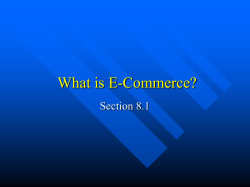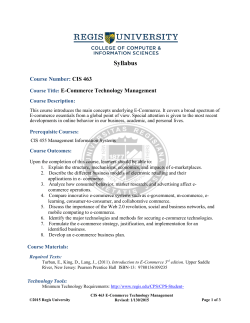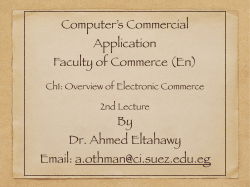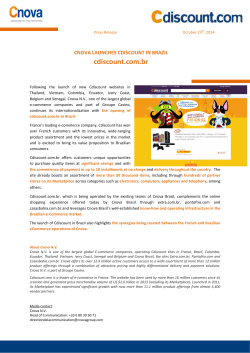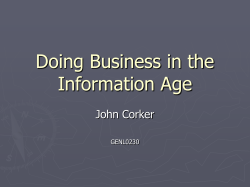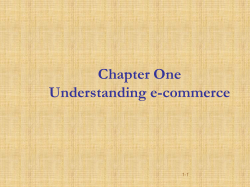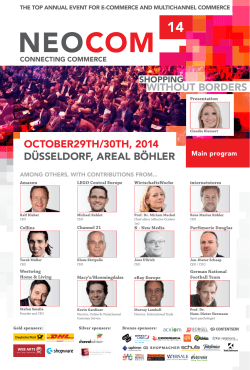
E-Commerce: Doing Business on the Internet
E-Commerce: Doing Business on the Internet Commerce The buying and selling of goods, especially on a large scale. Commerce is done between businesses, individuals, countries, and so on. E-Commerce What is E-Commerce? Doing business online, typically via the Web The use of the Internet and the web to transact business Digital enabled commercial transactions between and among organizations and individuals. It refers to business activities conducted using electronic data transmission via the Internet and the World Wide Web. Although consumer shopping on the Web was running about $50 billion per year in 2001 and $350 billion by 2004, The First E-Commerce? In 1886, a telegraph operator was able to obtain a shipment of watches that was refused by the local jeweler. Using the telegraph, he sold all the watches to fellow operators and railroad employees. Within a few months, he made enough money to quit his job and start his own store. The young man's name was Richard Sears. His company later became Sears, Roebuck. The Networked Organization EC Definitions & Concepts Electronic Commerce (EC) is the process of buying, selling, or exchanging products, services, and information via computer networks EC defined from these perspectives Communications Business process Service Online Collaborations Community How eCommerce works The consumer moves through the internet to the merchant's web site. From there, he decides that he wants to purchase something, so he is moved to the online transaction server, where all of the information he gives is encrypted. Once he has placed his order, the information moves through a private gateway to a Processing Network, where the issuing and acquiring banks complete or deny the transaction. This generally takes place in no more than 5-7 seconds. There are many different payment systems available to accommodate the varied processing needs of merchants, from those who have a few orders a day to those who process thousands of transactions daily. With the addition of Secure Socket Layer technology, eCommerce is also a very safe way to complete transactions. Marketplaces vs. E-marketplaces A marketplace is a location where goods and services are exchanged. The traditional market square is a city square where traders set up stalls and buyers browse the merchandise. This kind of market is very old, and countless such markets are still in operation around the whole world. An e-marketplace is an electronic exchange where firms register as sellers or buyers to communicate and conduct business over the Internet. E-Marketplace include electronic transaction E-Marketplace components are customers, sellers, goods, infrastructure, a front end, a back end and support services EC Definitions & Concepts (cont.) E-business is a broader definition of EC that includes not just the buying and selling of goods and services, but also Servicing customers Collaborating with business partners Conducting electronic transactions within an organization Pure vs. Partial EC: based on the degree of digitization of product, process, delivery agent E-Business is not just about eCommerce or exchanging information about goods and services between you and your customers and your and your suppliers. It is about using the Internet for the transfer of information between employees using your in-house systems, between branch offices, between remote users, and between business partners, customers, suppliers and the public . E-Business is also about automation. You can automate many of your in-house procedures using new sources of information. You are freed up so you can use information and technology to let you work AT your business rather that IN your business . Why eCommerce is changing the Way Businesses Operate? reduced costs lower product cycle times faster customer response improved service quality Internet Technology and the Digital Firm Round-the-clock service: Web sites available to consumers 24 hours a day Extended distribution channels: Outlets created for attracting customers who otherwise would not patronize Reduced transaction costs: Costs of searching for buyers, sellers, etc. reduced New Business Models Business Model: Defines an enterprise Describes how the enterprise delivers a product or service Shows how the enterprise creates wealth The Changing Economics of Information Information asymmetry: One party in a transaction has more information than the other Increases richness: Depth and detail of information Increases reach: Number of people contacted The Changing Economics of Information New levels of richness and reach attainable ENABLERS Explosion of connectivity Dissemination of standards Reach Internet Business Models • Virtual storefront: Sells goods, services on-line • Information broker: Provide info on products, pricing, etc. • Transaction broker: Buyers view rates, terms from various sources Online Marketplace: Concentrates information from several providers Content provider: Creates revenue through providing client for a fee, and advertising On-line service provider: Provides service, support for hardware, software products Virtual community: Chat room, on-line meeting place Portal: Initial point of entry to Web, specialized content, services Auction: Products, prices, change in response to demand. Used in online marketplaces • • • • • • The Dimensions of Electronic Commerce EC Definitions & Concepts (cont.) Traditional commerce: all dimensions are physical Brick-and-mortar organizations Old-economy organizations (corporations) Perform all business off-line Sell physical products by means of physical agents EC Definitions & Concepts (cont.) Pure EC: all dimensions are digital Pure online (virtual) organizations New-economy organization Sell products or services only online Partial EC: a mix of digital and physical dimensions Click-and-mortar organizations Conduct EC activities Do their primary business in the physical world Electronic Markets vs. Interorganizational Systems E-markets Buyers and sellers meet to exchange Goods Services Money Information Interorganizational Information Systems (IOS) Between two or more organizations Routine transaction processing Information flow The EC Framework and Field An EC Framework EC applications supported by infrastructure and 5 support areas People Public policy Technical standards and protocols Business partners Support services A Framework for EC 7 Unique Key ideas in Ecommerce Ecommerce Ubiquity Global Reach The technology works through interaction with the user Two way communication between merchant and consumer Information density Video, audio, text message are possible The complexity and content of a message Interactivity There is one set of the technology standards, namely Internet standards Richness The technology reaches across national boundaries, around the earth The total number of users or customers an eCommerce can obtain Universal standards Internet/Web technology is available everywhere; at all time The technology reduces information costs and raises quality The total quality and amount of information available to all market participates Personalization/Customization The technology allows personalized messages to be delivered to individuals as well as group Classification of EC by the Nature of the Transaction Business-to-business (B2B) : EC model in which all of the participants are businesses or other organizations Business-to-consumer (B2C): EC model in which businesses sell to individual shoppers Business-to-business-to-consumer (B2B2C): EC model in which a business provides some product or service to a client business; the client business maintains its own customers, to whom the product or service is provided Classification of EC by the Nature of the Transaction (cont.) Consumer-to-business(C2B): individuals who use the Internet to sell products or services to organizations and /or seek sellers to bid on products or services they need Consumer-to-consumer (C2C) : consumers sell directly to other consumers Classification of EC by the Nature of the Transaction (cont.) Mobile commerce (m-commerce)—EC transactions and activities conducted in a wireless environment Location-commerce—(l-commerce) m-commerce transactions targeted to individuals in specific locations, at specific times Classification of EC by the Nature of the Transaction (cont.) Intrabusiness (organizational) EC: EC category that includes all internal organizational activities that involve the exchange of goods, services, or information among various units and individuals in an organization Classification of EC by the Nature of the Transaction (cont.) Business-to-employee (B2E): EC model in which an organization delivers services, information, or products to its individual employees Collaborative commerce (c-commerce): EC model in which individual or groups communicate or collaborate online E-government: Government-to-citizens (G2C): EC model in which a government entity buys or provides good, services, or information to businesses or individual citizens Business to Government Internet commerce This term refers to the use of the Internet by Government to reach its citizens for a variety of information dissemination purposes and transactions. What is Business-to-Government? Definition: Business-to-government, meaning that the primary focus is toward government agencies at the national, state or local level. Also Known As: Business-to-Government, B2G, B-to-G Classification of EC by the Nature of the Transaction (cont.) Exchange (electronic): a public e-market with many buyers and sellers Exchange-to-exchange (E2E): EC model in which electronic exchanges formally connect to one another for the purpose of exchanging information M-commerce or mobile commerce M-commerce or mobile commerce stands for electronic commerce made through mobile devices. M-commerce is currently mainly used for the sale of mobile phone ring-tones and games, it is increasingly used to enable payment for location-based services such as maps, as well as video and audio content, including full length music tracks. Other services include the sending of information such as football scores via SMS. Currently the main payment methods used to enable m-commerce are: 'M-commerce' was coined in the late 1990s during the dot-com boom. The idea that highly profitable M-commerce applications would be possible though the broadband mobile telephony provided by 2.5G and 3G cellphone services was one of the main reasons for hundreds of billions of dollars in licensing fees paid by European telecommunications companies for UMTS and other 3G licenses in 2000 and 2001. Other examples of M-commerce applications are premium-rate calling numbers, charging to the mobile telephone user's bill or deducting from their calling credit, either directly or via reverse-charged SMS. information-on-demand systems like news services or stock tickers, banking and stock brokerage applications by SMS, WAP or iMode. Advantages of M-Commerce The benefits of M-Commerce include customer satisfaction, cost savings, and new business opportunities. The Benefits of EC Benefits to Organizations Expands the marketplace to national and international markets Decreases the cost of creating, processing, distributing, storing and retrieving paper-based information Allows reduced inventories and overhead by facilitating pull-type supply chain management The pull-type processing allows for customization of products and services which provides competitive advantage to its implementers Reduces the time between the outlay of capital and the receipt of products and services Supports business processes reengineering (BPR) efforts Lowers telecommunications cost - the Internet is much cheaper than value added networks (VANs) Benefits of EC (cont.) Benefits to consumers Enables consumers to shop or do other transactions 24 hours a day, all year round from almost any location Provides consumers with more choices Provides consumers with less expensive products and services by allowing them to shop in many places and conduct quick comparisons Allows quick delivery of products and services (in some cases) especially with digitized products Consumers can receive relevant and detailed information in seconds, rather than in days or weeks Makes it possible to participate in virtual auctions Allows consumers to interact with other consumers in electronic communities and exchange ideas as well as compare experiences Facilitates competition, which results in substantial discounts Advantages of E-Commerce: Summary Electronic commerce can increase sales and decrease costs. A business can reduce its costs by using electronic commerce in its sales support and ordertaking processes. Amazon offers a feature that no normal store offers. When you read the description of a book, you also can see "what other people who ordered this book also purchased". That is, you can see the related books that people are actually buying. Because of features like these it is common for people to buy more books that they might buy at a normal bookstore. Integration into the business cycle – if an e-commerce site is implemented well, the web can significantly lower both order-taking costs up front and customer service costs after the sale by automating processes. 24/7 -online shops do not close Larger purchases per transaction – Electronic commerce increases sale opportunities for the seller. Electronic commerce increases purchasing opportunities for the buyer Lower transaction costs – Web advertising reaches a large amount of potential customers throughout the world. The Web creates virtual communities for specific products or services. A Web site that is well-integrated into the business cycle can offer customers more information than previously available. For example, if Dell tracks each computer through the manufacturing and shipping process, customers can see exactly where their order is at any time. This is what FedEx did when they introduced on-line package tracking - FedEx made far more information available to the customer. People can shop in different ways. Traditional mail order companies introduced the concept of shopping from home in your pajamas, and ecommerce offers this same luxury. New features that web sites offer include: The EC Framework and Field An EC Framework EC applications supported by infrastructure and 5 support areas People Public policy Technical standards and protocols Business partners Support services Building an E-commerce Site The things you need to keep in mind when thinking about building an e-commerce site include: Suppliers - this is no different from the concern that any normal store or mail order company has. Without good suppliers you cannot offer products. Your price point - a big part of e-commerce is the fact that price comparisons are extremely easy for the consumer. Your price point is important in a transparent market. Customer relations - E-commerce offers a variety of different ways to relate to your customer. E-mail, FAQs, knowledge bases, forums, chat rooms... Integrating these features into your e-commerce offering helps you differentiate yourself from the competition. The back end: fulfillment, returns, customer service - These processes make or break any retail establishment. They define, in a big way, your relationship with your customer. When you think about e-commerce, you may also want to consider these other desirable capabilities: Gift-sending Affiliate programs Special Discounts Repeat buyer programs Seasonal or periodic sales The reason why you want to keep these things in mind is because they are all difficult unless your e-commerce software supports them. If the software does support them, Implementing an E-commerce Site There are three general ways to implement the site with all sorts of variations in between. The three general ways are: Enterprise computing Virtual hosting services Simplified e-commerce Enterprise computing means that you purchase hardware and software and hire a staff of developers to create your e-commerce web site. Amazon, Dell and all of the other big players participate in e-commerce at the enterprise level. To consider enterprise computing solutions an organisations will be aiming to satify the following: Virtual hosting services give you some of the flexibility of enterprise computing, but what you get depends on the vendor. In general the vendor maintains the equipment and software and sells them in standardised packages. Part of the package includes security, and almost always a merchant account is also an option. Database access is sometimes a part of the package. You provide the web designers and developers to create and maintain your site. An example of a virtual hosting service is the type of package available at Bargain Host. Simplified e-commerce is what most small businesses and individuals are using to get into e-commerce. In this option the vendor provides a simplified system for creating your store. The system usually involves a set of forms that you fill out online. The vendor's software then generates all of the web pages for the store for you. A good examples of this sort of offering is ebay. These are in order of decreasing flexibility and increasing simplicity. Disadvantages of Electronic Commerce Some business processes are difficult to be implemented through electronic commerce. Return-on-investment is difficult to apply to electronic commerce. Businesses face cultural and legal obstacles to conducting electronic commerce. Major Business Pressures and the Role of EC The environment, pressure, and support model How to start your own online small business. E-Commerce is a six step process and all online businesses will go through the first three steps: 1. Create the online content. Content is King! 2. Host the content on the Internet. 3. Market the website and content. Businesses conducting online sales will need to continue through the final three steps: 4. Collect and record customer orders. 5. Process payments. 6. Fulfill customer orders. Creating The Online Content The one thing that controls the success or failure of a website above all else is content. Content is King. You customers must have a reason to visit the first time, two weeks later, and six months later. They need a reason to recommend a friend to your site. The best reason is content. Value Added Content The most succesful sites learn what their customers want and then give it to them! What do customers want? Information! You know something that your customers would find extremely valuable. Put it on your website. This could be tips and tricks for using a product, how to select a service, 5 ways to do something better - faster - easier! Here are some ideas from successful sites: Whitepapers - Detailed technical information and suggestions on how to use a product. Here at the Arkansas SBDC, we offer over 300 small business fact sheets in our BizFacts section. News - Not the newspaper news, but industry news related to your product or service. The kind they can't get anywhere else. Did you notice the eNews articles on the ASBDC homepage? Samples - Hold a monthly drawing for one or more free samples. This is a great way to build a database of sales leads! Never offer sample hard goods with out limiting the offer. Can you afford to mail a million plus samples? Pretty Pictures Your site needs to have a professional look. Hire someone to create your graphics. If you can't afford a professional, hire a college or high school student. Limit the number of pictures on your homepage. Your homepage needs to load quickly (7-10 seconds). Your customers want to be satisfied now. They are just one mouse click from leaving! Use the same color scheme and navigational elements on each page. First, this gives you a "corporate image." Second, a common peeve among web surfers is poor navigation on most sites. Hosting The Content After creating your content, the next step is to host the content on the Internet. One problem: most small businesses cannot afford the cost of purchasing a dedicated web server and renting high speed Internet access lines. The solution is simple. Rent space on a computer that's already connected to the Internet. Thanks to cheaper hard disk drives, storage space is widely available at very little cost. You should be able to locate a hosting service for as little as $10-20 per month, depending on features and extras. Domain Names As part of your hosting solution, you will also want to register a unique domain name for your website. The domain name allows your customers to enter a shorter and easier to remember address to your website. Having your own domain name also will make any future changes of hosting services much less difficult. Domain names are licensed for $35 per year. While a domain name can be registered with any of the six authorities, it is best for novices to register a domain name through their chosen web hosting service. Registering through a hosting service ensures that required domain name servers (DNS) are quickly and properly configured - a technical nightmare for both techies and non-techies. Most reputable hosting services assist in the registering of domain names at no extra cost. Marketing Your Website: methods for marketing a website You need to market your website and market continuously. This page contains numerous methods for marketing a website. You need to discover the methods that work best for you. E-mail Techniques E-mail Address – Locate and join 1-2 two large e-mail discussion lists that your target market also subscribes to. You can locate lists at PAML. Bulk E-mail – Configure your e-mail software to use a signature file or tagline. Create a 4-5 line ad for your site which gets attention, gives a reason to visit and provides the web address. Mailing Lists – First and foremost, your e-mail address should include your product, industry, or company name. Personal names and intials are for personal e-mail from friends and family. Signature Files – Although commonly overlooked and discounted by most individuals and businesses, e-mail is the most effective and cost efficient way to drive traffic to a website. Use your customer database to email all your customers with email addresses monthly. Products like Campaign make the process easy. Check with your e-mail service first as they may have a policy or limitations against bulk e-mail. World Wide Web Techniques In addition to e-mail, there are several web marketing techniques that are highly effective. While time consuming, take the time to register with search engines and develop reciprocal links. Brief History of EC EC applications first developed in the early 1970s Electronic funds transfer (EFT) Limited to: Large corporations Financial institutions A few other daring businesses Brief History of EC (cont.) Electronic data interchange (EDI)— electronic transfer of documents: Purchase orders Invoices E-payments between firms doing business Enlarged pool of participants to include: Manufacturers Retailers Service providers Brief History of EC (cont.) Interorganizational systems (IOS) Stock trading Travel reservation systems Internet became more commercialized in the early 1990s Almost all medium-and large-sized organization in the world now has a Web site Most large corporations have comprehensive portals Brief History of EC (cont.) EC Successes Pure online eBay VeriSign AOL Checkpoint Click-and-mortar GE IBM Intel Schwab EC Failures E-tailors began to fail in 1999 This does not mean that EC’s days are numbered Large EC companies like Amazon.com are expanding but success or failure is not certain
© Copyright 2025

